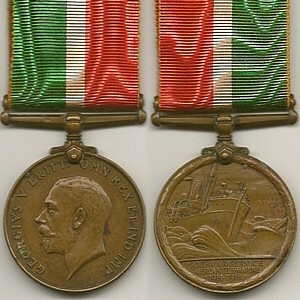| Mercantile Marine War Medal | |
|---|---|
 | |
| Type | Campaign medal |
| Awarded for | Campaign service |
| Description | Bronze circular medal |
| Country | |
| Presented by | the Monarch of the United Kingdom and the British Dominions, and Emperor of India |
| Eligibility | Merchant Marine mariners |
| Campaign(s) | First World War |
| Clasps | None |
| Established | 1919 |
| Total | 133,135 |
| Ribbon bar | |
| Order of wear | |
| Next (higher) | British War Medal |
| Next (lower) | Naval General Service Medal (1915) |

The Mercantile Marine War Medal was established in 1919 and awarded by the Board of Trade of the United Kingdom to mariners of the British Mercantile Marine (later renamed the Merchant Navy) [1] for service at sea during the First World War. [2] [3] [4]
